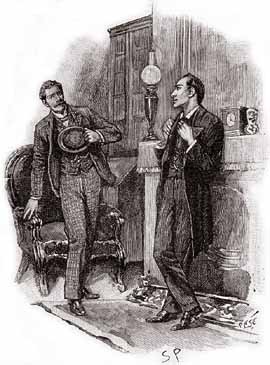A Scion Society of The Baker Street Irregulars

The 17 Steps: The Yellow Face
Seventeen thoughts for further ponderance of the case at hand – The Yellow Face (YELL)

THE STORY THAT COMES WITH A DISCLAIMER
The bracketed paragraph that introduces this story is an interesting commentary on what Watson thought of this story. The good doctor had published tales of Holmes failing before now (A Scandal in Bohemia and Speckled Band come quickly to mind), but with this one he feels he needs to warn the reader of Holmes’s impending failure. Why does Watson feel he needs to explain this one and not any before it? If a story has “features of interest,” as he says, shouldn’t his readers be able to pick that up on their own? Was Watson showing signs that he thought this was a poorer quality story over all?
THE SHERLOCK HOLMES EXERCISE PLAN
In the beginning of this tale, Watson gives us a brief summary of Holmes’s physical abilities (as strong as can be) and his training regimen (non-existent). Are we to believe that Holmes could perform feats of strength like bending fireplace pokers, not due to training but due to sheer force of will by that mighty brain? Or was all Holmes’s training and boxing practice done in his youth, giving him enough residual ability that he didn’t seem to need training during his time with Watson? Any theories?
THE NEW WATSON — SOFT ON DRUGS?
Earlier in the stories, in The Sign of the Four, Watson shows a strong disdain for Holmes’s drug use. Now the doctor is mentioning it with a much milder statement: “Save for the occasional use of cocaine, he had no vices, and he only turned to the drug as a protest against the monotony of existence when cases were scanty and the papers uninteresting.”
Is this change due to the fact Watson thought Holmes was dead when he wrote this tale, softening up the more sordid aspects of Holmes so as not to speak ill of the dead? Or is this a more realistic view of Holmes’s drug experimentation, not flavored with the irritation one harbors toward a room-mate’s bad habits that Watson may have felt while writing SIGN?
FREE CHESTNUTS?
Watson speaks of the chestnut leaves starting to emerge during their walk in the park. When these trees eventually started producing chestnuts on public grounds, who collected said chestnuts for roasting? Anyone who cared to?
HOLMES THE PIPE-LOVER
Sherlock Holmes’s fondness for pipes is displayed clearly in YELL as he rambles on about Grant Munro’s abandoned pipe: “A nice old brier with a good long stem of what the tobacconists call amber. I wonder how many real amber mouthpieces there are in London? Some people think that a fly in it is a sign.”
Before he even thinks of making deductions, he’s wondering about real amber and speaking of its lore. This time, instead of giving us data, he’s giving us questions, too. Just how many real amber mouthpieces might there have been in London at that time? And what exactly is a fly in the amber a sign of?
MUNRO THE PIPE-HATER
We are told Grant Munro cares enough for his old seven-shilling pipe to get it repaired time and again. Yet he’s in the habit of lighting it off of lamps and gas-jets, which chars the thing all along one side of the bowl. Would a man who really cared about his pipe constantly hold it in a flame like that? How hard was it to carry matches or a lighter along in those days?
IS THERE SOMETHING GRANT’S NOT TELLING US?
“It seems dreadful to discuss the conduct of one’s wife with two men whom I have never seen before,” a disturbed Grant Munro tells us at the outset. But as the story goes on, it gets harder and harder to see what he was talking about. One of these “men” was surely the yellow-faced person he saw at the window, but who was the other? Was the housekeeper’s face that harsh and forbidding that Munro thought of her as a man? Or is there some other tale of Effie and a couple of totally different guys that we never get to hear?
THE BURNING OF ATLANTA
“There was a great fire at Atlanta very shortly after his death, and all her papers were destroyed.” Poor Effie Hebron. First her husband dies of yellow fever, then all of her belongings are destroyed by fire. But was the fire just a story Effie used to cover all the belongings she left behind with her child? Or was i merely a fireplace blaze, and she destroyed the papers herself? How much does this oh-so convenient fire damage her credibility on other matters?
CUTTING HERSELF OFF
“I cut myself off from my race in order to wed him,” Effie says of John Hebron. But does she actually mean “my race” or “my family”? The nationality and description of her child’s nurse seems to indicate that Effie hadn’t cut herself off entirely from her race. And who was it that young Effie went to America with to begin with? Was her own family part of what sickened her about America, leaving her to flee to a sympathetic aunt?
THE AGE OF ABANDONMENT
We meet Effie Munro’s little girl at the end of the story, and she is described as just that “a little girl.” How old was Effie’s child, and how old was she three years ago when her mother left her behind? Would she have been more likely to abandon an infant who could not yet speak than to have abandoned a child who was old enough to ask “why”?
MAY-DECEMBER MARRIAGES IN ATLANTA
“Her husband had left her comfortably off . . . she had a capital of about four thousand five hundred pounds.” Doing a quick calculation using Chris Redmond’s web page equation of roughly $100 in current U.S. funds to every Canonical pound, this means Effie’s late husband was worth about $450,000. As Effie was only about 24 years old when John Hebron died, she could not have been much past twenty when she met him. But how old was Hebron? While the couple’s racial difference lies at the heart of this tale, what of the couple’s age difference? How old would an Atlanta lawyer have to be to have a bankroll equivalent to a half million in modern American dollars? Was Hebron a *much* older man?
AND WHILE WE’RE ON HEBRON’S BANKROLL . . .
Less than twenty years after the American Civil War, we find John Hebron, an African-American lawyer in Atlanta with a lot of money. While it was a time of change and dramatic change at that, could we expect any local in post-war Atlanta to rise so quickly? Or is his wealth an indication that Hebron came to America from somewhere in Europe or the Northern U.S. when the war was over, trying to either help out or take advantage of the situation?
WHERE DID ALL THAT MONEY GO?
“I am a hop merchant myself, and as I have an income of seven or eight hundred, we found ourselves comfortably off and took a nice eighty-pound-a-year villa at Norbury.”
When you calculate the combined income of the Munros at well over a thousand pounds a year, they seem to have quite a bit of money to play with. Their eighty-pounds-a-year villa almost seems economical when looked at next to their income. Were the Munros saving the lion’s share of their income? Given the money-wise part of Effie’s first husband’s character, would we expect anything less of her choice in a second husband?
AN HOUR AT THE CRYSTAL PALACE
The distraught Grant Munro winds up walking to the Crystal Palace, and there spends an hour on the grounds. What might he have done during that hour? Lunchtime was nearing, what might Munro have found to eat in that area if he hadn’t lost his appetite?
THE YELLOW FACE ITSELF
Holmes “peels” the yellow face mask off of the little Hebron girl. Does this mean it was made of rubber, or some other material that would have kept it flexible and close to her face? Were masks at the time made of rubber, paper, paper mache, or another material?
HOW MUCH MONEY DID THE NURSE HAVE?
Grant Munro is fairly specific about how much Effie was worth when he married her. But was a portion of Effie’s money left with the nurse to care for her daughter? How did the child and the nurse get by? Were the surviving members of John Hebron’s family involved in that three year period?
WHY DID HOLMES TAKE THIS ONE SO HARD?
Like Watson in his explanatory words at the case’s beginning, Holmes seems greatly bothered by his performance in this case, telling his friend, “if it should ever strike you that I am getting a little over-confident in my powers, or giving less pains to a case than it deserves, kindly whisper ‘Norbury’ in my ear, and I shall be infinitely obliged to you.”
Would anyone accuse Holmes of giving this case less than it deserved? Was there anything he could have done to have caused a happier outcome?
The Seventeen Steps originally appeared on the Hounds of the Internet e-list from September 2000 to October 2001 and later on the Sherlock Peoria blog.
 Brad Keefauver, the 41st Garrideb, is the author of The Elementary Methods of Sherlock Holmes, Sherlock and the Ladies, and The Armchair Baskerville Tour. Former publisher of The Holmes & Watson Report, The Dangling Prussian, and a whole lot of obscure, collectable little things on our boy Sherlock. Keefauver is a member of the Baker Street Irregulars and the Adventuresses of Sherlock Holmes.
Brad Keefauver, the 41st Garrideb, is the author of The Elementary Methods of Sherlock Holmes, Sherlock and the Ladies, and The Armchair Baskerville Tour. Former publisher of The Holmes & Watson Report, The Dangling Prussian, and a whole lot of obscure, collectable little things on our boy Sherlock. Keefauver is a member of the Baker Street Irregulars and the Adventuresses of Sherlock Holmes.

Sorry, comments are closed for this post.